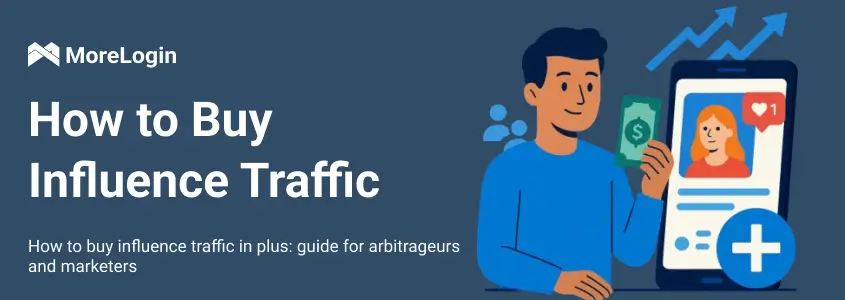
- Product

- Pricing
- Affiliate Program
- Use Cases
- Resource


If you’ve ever seen a blogger smiling while showing off how they “made a bunch of money” in a casino or on betting, and then sharing a link or promo code — congratulations, you’re already familiar with the world of influence traffic.
These types of integrations are what push iGaming and betting content to the top on Telegram, YouTube, and Instagram.
Today, let’s break down:
how to choose bloggers without blowing your budget,
which creatives actually work,
what mistakes kill ROI,
and as a cherry on top — a couple of top influencers from India if you want to run campaigns there.
Working with influencers always starts with platform selection. A blogger might look perfect on the outside: millions of views, beautiful feed, great delivery. But behind it could be fake stats, bot followers, or simply the wrong target audience. To avoid going into the red:
Ask for screenshots or videos showing the stats of their recent posts or stories. Compare them to the numbers they claim. Any mismatch is a red flag.
Check engagement: likes, comments, reposts, reactions. If they claim 200K reach and only have 100 likes — bad sign. Average engagement for a real audience: 1–3%.
Manually check for fake followers: Open comments and follower profiles. If you see repetitive comments, accounts without photos, or suspicious usernames — something’s fishy.
Assess their ad style: Even with decent numbers, it’s important how they deliver ads: naturally or bluntly. If the ad feels forced, conversion chances drop.
Check geo and age: Don’t buy ads from a blogger whose audience is mostly schoolkids or from a region that doesn’t match your offer. Solid stats and smart analysis are a must.
Telegram: Best-performing content is short, punchy, and emotional. Use minimal text and max visual impact. GIFs, video bubbles, screenshots of winnings — all of that grabs attention fast.
Your headline needs to hit pain points or spark curiosity instantly. To boost engagement and click-throughs, always add buttons, reactions, polls, or other interactive elements.
What doesn’t work: long walls of text, outdated 2010s-style banners, dry delivery.
YouTube: Native ads and storytelling win here. Ads should feel like a natural part of the video — maybe a personal story, a challenge, or an experiment.
Avoid dry, direct promos: audiences respond better to emotion, live reactions, and realistic plots.
Keep the style casual and the integration short — no more than 1–2 minutes to avoid losing viewers. Don’t rely on pre-rolls, dull mid-rolls, or links in descriptions with no context — these bring little return.
Instagram: Stories work only with proper warming up. Start with a teaser like: “Tonight I’ll share how I made money…”
Then drive engagement through polls, reactions, or questions to get users interacting.
Always show the product in action — app interface, placing bets, withdrawing money — this builds trust.
Emotions, a real face, and dynamic visuals are key — otherwise, people just skip through. Don’t drop the link in the first story, don’t use boring static screens, and don’t forget storytelling — without it, stories flop.
Once the blogger is chosen and the creative is ready — don’t launch immediately.
Start with a test integration. A small run reveals everything: audience response, engagement level, expected results. It’s better to spend a little at first than blow the whole budget for nothing.
Next — tracking and unique links. Each blogger and campaign must have a dedicated link.
If you use Keitaro or any other tracking system, set up the campaign with clear segmentation to know what worked and where.
Don’t forget cloaking and link shortening. Platforms like Instagram and YouTube often cut reach on visible links, so cloak and shorten them using dedicated services.
Another crucial point — security and multi-accounting.
If you're managing several projects or geo-targets, use an anti-detect browser like MoreLogin. This protects your accounts, separates work profiles, and avoids ad platform bans — especially important in gray or sensitive niches.
And always run a final pre-launch check: the link works, tracking is functional, text and visuals are clean, and the creative doesn’t look like a banner from 2010. Only then — go live.
Once the integration goes live, the most important thing is to calculate ROI.
If ROI is above 100%, it’s time to scale: buy more, find similar blogs, increase volume.
If ROI is between 30–100%, optimize — maybe tweak the creative, change delivery, or refine the offer.
If ROI is below 30%, stop and look for new bundles to avoid wasting money.
Never judge after one integration — sometimes a setup only starts performing on the second or third try.
Working with influence traffic isn’t a “set and forget” game.
It requires constant analysis, smart blogger selection, quality creatives, and thorough tracking.
But with the right approach, it can become one of the most profitable channels in iGaming or betting.
If you'd like, I can help you with blogger selection or writing creatives for your offer.